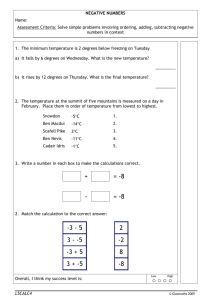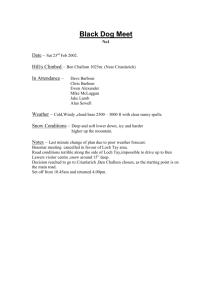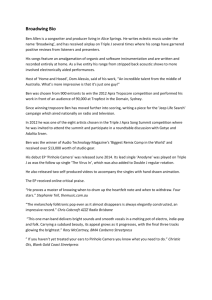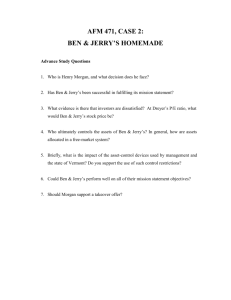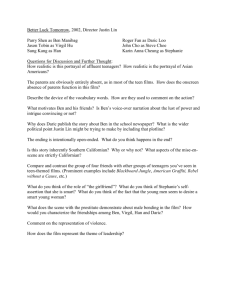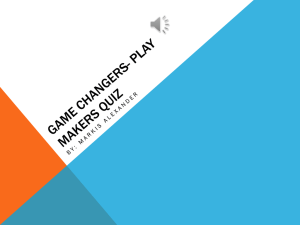Homeostasis Webquest: Ben's Bad Day - Biology
advertisement
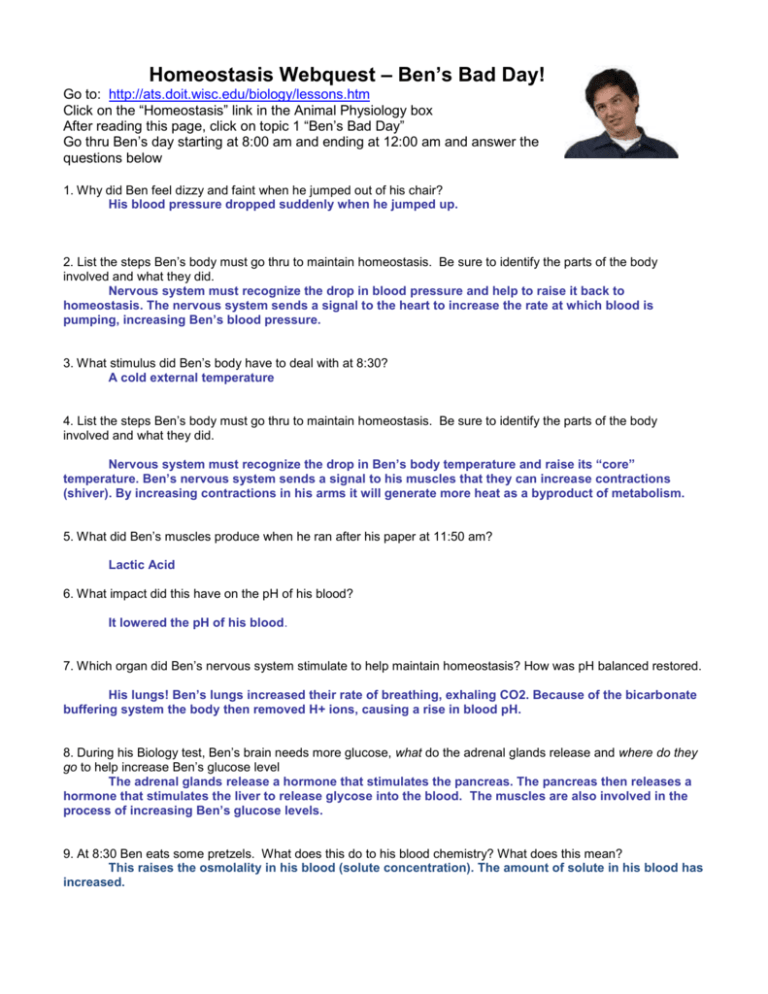
Homeostasis Webquest – Ben’s Bad Day! Go to: http://ats.doit.wisc.edu/biology/lessons.htm Click on the “Homeostasis” link in the Animal Physiology box After reading this page, click on topic 1 “Ben’s Bad Day” Go thru Ben’s day starting at 8:00 am and ending at 12:00 am and answer the questions below 1. Why did Ben feel dizzy and faint when he jumped out of his chair? His blood pressure dropped suddenly when he jumped up. 2. List the steps Ben’s body must go thru to maintain homeostasis. Be sure to identify the parts of the body involved and what they did. Nervous system must recognize the drop in blood pressure and help to raise it back to homeostasis. The nervous system sends a signal to the heart to increase the rate at which blood is pumping, increasing Ben’s blood pressure. 3. What stimulus did Ben’s body have to deal with at 8:30? A cold external temperature 4. List the steps Ben’s body must go thru to maintain homeostasis. Be sure to identify the parts of the body involved and what they did. Nervous system must recognize the drop in Ben’s body temperature and raise its “core” temperature. Ben’s nervous system sends a signal to his muscles that they can increase contractions (shiver). By increasing contractions in his arms it will generate more heat as a byproduct of metabolism. 5. What did Ben’s muscles produce when he ran after his paper at 11:50 am? Lactic Acid 6. What impact did this have on the pH of his blood? It lowered the pH of his blood. 7. Which organ did Ben’s nervous system stimulate to help maintain homeostasis? How was pH balanced restored. His lungs! Ben’s lungs increased their rate of breathing, exhaling CO2. Because of the bicarbonate buffering system the body then removed H+ ions, causing a rise in blood pH. 8. During his Biology test, Ben’s brain needs more glucose, what do the adrenal glands release and where do they go to help increase Ben’s glucose level The adrenal glands release a hormone that stimulates the pancreas. The pancreas then releases a hormone that stimulates the liver to release glycose into the blood. The muscles are also involved in the process of increasing Ben’s glucose levels. 9. At 8:30 Ben eats some pretzels. What does this do to his blood chemistry? What does this mean? This raises the osmolality in his blood (solute concentration). The amount of solute in his blood has increased. 10. What happened next in Ben’s body’s attempt to restore homeostasis? The nervous system stimulates the pituitary gland which releases an antidiuretic hormone into the blood. 11. What organ was stimulated by the above action by Ben’s body? What was its response? Ben’s kidney’s responded by reabsorbing water back into the blood, increasing the volume of Ben’s blood. 12. What did Ben do to increase his glucose level? Drank a soda 13. How does Ben’s body respond to the increased glucose level? He gets really hyper. His pancreas releases insulin into his blood. 14. Which part of Ben’s body is stimulated to take up the excess glucose? Liver 15 What other parts of Ben’s body work to maintain homeostasis in the above situation? Adrenal Glands, Kidney, Muscles, Heart, Lungs and Pituitary Glands. 16. What part DOES NOT assist in this process and why? They all do! Scroll to the bottom of the page and click the arrow indicating the next page. Read this page and answer the questions below. 17. Which body messenger service is most like email? Most like “snail mail”? Nervous System/Endocrine System 18. What are the messenger molecules used by the nervous system? The endocrine system? Neurotransmitters/ Hormones Click on the arrow at the bottom of the pages to continue thru this section of the webquest. 19. Describe the path that the neurotransmitter took to increase Ben’s blood pressure. First a messenger molecule is released. It then travels to its target and binds to a receptor. The pacemaker cell changes its membrane permeability, allowing for electron signals to fire to Ben’s heart muscles. This results in a higher heart rate as well as a higher blood pressure. 20. Describe the path that the hormones took to regulate Ben’s glucose level. First a messenger molecule is released. It then travels to its target and binds to a receptor. The liver cell causes the cell to take up glucose from the blood. This increases Ben’s glucose level. 21. Can both the endocrine and the nervous system work together to maintain Homeostasis? Give an example from Ben’s bad day in which both systems played a part. Yes they can, an example was when Ben hadn’t eaten all day and he ate some pretzels on his way to a party. 22. Which system kicked in first? Nervous system. 23. What part of the endocrine system was stimulated, what hormone was released, where did it go, and what was the target cell’s response? The pituitary cell was stimulated releasing ADH into the blood. The ADH cells went to various organs but bound to the outside of the kidney cells. The target cells response was to change its permeability and reabsorb water. This increases blood volume and decreases osmolarity. 24. Read the want adds below and determine if Neurotransmitters or hormones are best suited for the job? Seeking highly qualified messenger molecule to work with a variety of target organs. Must be willing to travel long distances to remote parts of the body. Email rm@ina.co HORMONES Earn up to $75/hr! Homeostatic Network, Inc. has immediate openings for messenger molecules. Must be able to meet with both target and not target organs Please call 5640936 HORMONES Wanted: Messenger molecule for established homeostatic regulatory system. Must have experience working as pare of a network of connected cells and be able to reach target cells rapidly. Direct inquiries …6539988 NEURO 25. Are the homeostatic processes included in this webquest positive or negative feed back? Explain.

